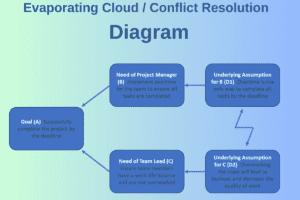Create a Project Charter: Step by Step Guide to the Creation Process
Welcome to our comprehensive guide on how to create a project charter. A project charter is a formal document that defines the scope, objectives, and stakeholders of a project. It is an essential element that sets the foundation for project success. By following this step-by-step guide, you will learn how to write a project charter to ensure your project’s success.
Key Takeaways:
- Creating a project charter is a crucial aspect of project management
- A project charter is a formal document that outlines the scope, objectives, and stakeholders of a project
- The charter serves as the foundation for project success by defining clear boundaries and expectations
- The key elements of a project charter include project scope, objectives, sponsor, team, and budget
- A project management charter template can simplify the creation process
The Importance of a Project Charter
When it comes to project management, a project charter plays a vital role in ensuring project success. But, what is a project charter? It is a formal document that outlines the purpose, objectives, scope, and key elements of a project. Simply put, the charter acts as a foundation for project management and helps differentiate it from other project charters.
Without a charter, a project runs the risk of wandering aimlessly and not meeting its desired outcomes. By having a project charter, the project team can align with the project goals and ensure that everyone involved has a clear understanding of its goals and boundaries.
The project charter is not to be confused with other types of charters, such as a product charter or a team charter. These charters, while similar, serve different purposes. The purpose of a project charter is to guide the project management process and act as a central reference point throughout the project’s lifecycle.
“A project without a charter is like a ship without a compass, destined to drift without direction.” – Wysocki, Robert. Effective Project Management: Traditional, Agile, Extreme, Seventh Edition
Key Elements of a Project Charter
In order to create a comprehensive project charter, it is important to include the following key elements:
| Project Scope | The project scope outlines the deliverables and tasks involved in the project. It defines the boundaries of the project and ensures everyone involved has a clear understanding of what is included and what is not. |
|---|---|
| Project Objectives | Project objectives define the desired outcomes. What is it that needs to be achieved by the end of the project? Objectives should be specific, measurable, achievable, relevant, and time-bound. |
| Project Sponsor | The project sponsor is the person who authorizes the project. This person should have a vested interest in the project and be willing to provide the necessary resources for its successful completion. |
| Project Team | The project team consists of individuals responsible for the execution of the project. It is important to clearly define roles and responsibilities to avoid confusion and promote a collaborative environment. |
| Project Budget | The budget determines how much the project will cost. It is important to accurately estimate costs and allocate resources accordingly to avoid cost overruns. |
By including these key elements in your project charter, you will be able to clearly define the project’s scope and objectives, identify the project sponsor and team, and allocate resources appropriately to stay within budget.
Creating a Project Charter Template

Creating a project charter can be a time-consuming task, but there is a solution. You can use a project charter template to simplify the process. These templates are pre-designed documents that provide a structure for the project charter and include all the necessary information that needs to be added.
The project charter template should include detailed sections that cover project description, objectives, scope, timeline, milestones, and stakeholders. By using a template, it can serve as a starting point and be customized to fit the specific needs of your project. This ensures that all essential details are present, saving you time and reducing the chances of mistakes.
There are numerous free project charter templates available online that can be used for reference and inspiration. By using these templates, you can get a better idea of the structure and organization of the project charter.
Project Charter Example:
| Section | Description |
|---|---|
| Project Title | The title of the project |
| Project Scope | An overview of what the project will achieve and what it won’t achieve |
| Project Objectives | The goals that the project aims to achieve |
| Project Timeline | The estimated start and end date of the project |
| Project Milestones | The specific milestones that need to be achieved during the project |
| Stakeholders | A list of all stakeholders involved in the project |
Using a project charter template ensures that the project management team and stakeholders have clarity on the project’s goals, objectives, and stakeholder expectations, enabling them to work together more effectively to achieve project success.
Step-by-Step Process of Creating a Project Charter
Creating a project charter can seem like a daunting process, but it can be broken down into simple steps:
Gather All Necessary Information
Start by gathering all the information about the project, including its vision, objectives, deliverables, and stakeholders. Doing so will help you define the project’s scope and boundaries that will be outlined in the project charter.
Tip: Set up a meeting with stakeholders to ensure you have all the necessary information and to get their inputs on the project’s goals.
Outline the Project Scope and Timeline
Once you have all the information you need, it’s time to outline the project scope and timeline. Define the project’s boundaries and what the project will deliver. Consider the tasks included in the project and how long each task will take. This will give you a clear view of the project schedule.
Identify Key Project Team Members
Determine the key project team members involved in the project and their roles. Outline each team member’s responsibilities and deliverables. This approach will ensure every team member knows their role and the expectations placed on them.
Involve Relevant Stakeholders
Include all relevant stakeholders in the project charter creation process. This will help you get different perspectives and insights that will make the project charter more comprehensive. Ensure that you involve your stakeholders in the decision-making process, this will secure their buy-in and align expectations.
Create a Comprehensive Project Charter
Compile the information gathered from the previous steps into a single document that is the project charter. A project charter should include the project’s vision, objectives, milestones, budget, and timeline. including all the necessary information in one document will ensure that everyone involved in the project understands the project’s scope, objectives, and boundaries. Create an action plan based on the charter, highlighting key areas of focus and communication avenues.
Getting Stakeholder Buy-In
Securing stakeholder buy-in is critical to the success of any project. Engage with your project stakeholders early in the creation process to ensure their input is included in the project charter. By involving stakeholders, you can increase collaboration throughout the project lifecycle and promote a sense of ownership among participants.
Identify Key Stakeholders
The first step in involving stakeholders is to identify who they are. Typically, project stakeholders are individuals or groups who will be affected by the project outcome or have the potential to impact the project’s success. Examples of stakeholders include project sponsors, customers, end-users, project teams, and executives.
Solicit Feedback and Address Stakeholder Concerns
After identifying stakeholders, involve them in the creation process by soliciting their feedback. Address their concerns and interests to ensure buy-in and project success. You may also consider creating a stakeholder analysis to understand their goals and expectations better.
Highlight Stakeholder Contributions in the Project Charter
When creating the project charter, be sure to highlight stakeholder contributions and acknowledge their involvement. Doing so lets stakeholders know that their opinions were appreciated and valued during the creation of the project charter. This acknowledgment can help build trust and increase buy-in throughout the project lifecycle.
From Project Charter to Project Plan

Once your project charter has been approved and stakeholders have bought into it, managing your project from start to finish requires developing a project plan, which serves as a roadmap to success. The project plan is a detailed document that builds on the elements outlined in the project charter, including scope, objectives, timeline, and budget.
By expanding on these elements, the project plan guides the project team’s execution and outlines the necessary steps, resources, and activities needed to complete the project successfully. As a high-level document, the project charter focuses on the project’s purpose and key stakeholders, while the project plan explores the practical details of bringing the project to fruition.
One way to ensure that your project plan has all the necessary components is to develop a project plan template that mirrors your project charter. A typical project plan includes details on project milestones, deliverables, timelines, and team member responsibilities.
| Project Plan Elements | Description |
|---|---|
| Scope | Outline the project’s objectives, deliverables, and tasks. |
| Timeline and Milestones | Specify the project’s timeline, including the start and end dates and significant milestones. |
| Resources | Identify the resources required to execute the project successfully, including team members, equipment, and budget. |
| Risk Management | Anticipate potential risks and outline plans to mitigate them. |
| Communication Plan | Specify the communication channels to be used throughout the project and how often communication will take place. |
A well-crafted project plan sets the foundation for success and enables you to monitor progress against key milestones and timelines. Additionally, it helps keep your team members aligned and working towards common goals while providing stakeholders with a clear understanding of the project’s progression and potential roadblocks. Use your project charter as a starting point and turn it into a comprehensive project plan to manage your project’s timeline, resources, and objectives effectively.
Tracking and Adjusting the Project
Throughout the lifespan of a project, tracking its progress is crucial to ensure its success. Utilizing project management software or tools can help monitor the project timeline, milestones, and the progression of tasks. Regular communication with the team and stakeholders can address challenges and changes that may arise, allowing the project to stay on track and align with its objectives.
Tracking the project timeline enables the project team to keep tabs on deadlines and deliverables, ensuring they are completed on time. It also helps to identify potential bottlenecks and delays, allowing stakeholders to take corrective action promptly.
In addition to tracking the timeline, tracking the progression of tasks ensures all the project requirements are met within the allocated timeframe. Regular updates to the project schedule and milestone tracker allow for timely adjustments to align with the project objectives.
Using Project Management Software
Project management software can ease the tracking process and provide detailed reports on project progress. It offers a single platform where project managers can control all aspects of the project, including assigning tasks to team members, monitoring progress, tracking budget, and documenting the project’s reports.
A wide range of project management software is available in the market based on project requirements and budget. Some popular project management software tools include Asana, Trello, Microsoft Project, and Smartsheet.
The key to successful project management is staying organized and on schedule.
Tracking and adjusting the project’s progress is crucial to ensure its timely delivery and success. It is essential to use project management software or tools to keep an eye on the project timeline, milestone tracker, and the progression of tasks. Regular communication with the stakeholders can ensure that the project remains on track and aligns with its objectives.
FAQ
What is a project charter?
A project charter is a formal document that defines the scope, objectives, and stakeholders of a project. It provides a high-level overview of the project and acts as a contract between the project sponsor, stakeholders, and the project team.
Why is a project charter important?
A project charter is important because it sets the foundation for successful project management. It helps differentiate the project from others, defines its purpose and objectives, and provides clarity on its scope and boundaries. Having a project charter ensures that everyone involved in the project has a clear understanding of its goals and expectations.
What are the key elements of a project charter?
The key elements of a project charter include the project scope, objectives, sponsor, team, and budget. The project scope outlines the project deliverables and tasks involved, while the objectives define the desired outcomes. The project sponsor is the person who authorizes the new project, and the project team consists of individuals responsible for its execution. The budget determines the financial resources allocated to the project.
How can I create a project charter?
To create a project charter, you can use a project charter template as a starting point. The template should include sections for the project description, objectives, scope, timeline, milestones, and stakeholders. Customize the template to fit the specific needs of your project. There are free project charter templates available online that you can use for reference and inspiration.
What is the step-by-step process of creating a project charter?
The step-by-step process of creating a project charter involves gathering necessary information about the project, including its vision, objectives, deliverables, and stakeholders. Outline the project scope, timeline, milestones, and schedule. Identify key team members and involve relevant stakeholders for their inputs. Ensure that the project charter reflects the collective understanding and agreement of all parties involved.
How do I get stakeholder buy-in for the project charter?
To secure stakeholder buy-in, engage with them early on in the creation process. Solicit their feedback and address any concerns they may have. By involving stakeholders and considering their interests, you increase the chances of project success and foster collaboration throughout the project lifecycle.
What’s the difference between a project charter and a project plan?
A project charter is a high-level document that defines the purpose, scope, and objectives of a project. It acts as a contract between the project sponsor, stakeholders, and the project team. On the other hand, a project plan expands upon the elements outlined in the project charter. It delves into more detail, outlining the steps, resources, and activities necessary to complete the project successfully.
How do I track and adjust the project based on the project charter?
To track and adjust the project, utilize project management software or tools that allow you to monitor the project timeline, milestones, and the progression of tasks. Regularly communicate with the project team and stakeholders to address any challenges or changes that may arise. This iterative process ensures that every project stays on track and aligns with its objectives.
Conclusion
Creating a project charter is a vital step in ensuring project success. By defining the project’s scope, objectives, and stakeholders, you can stay on track and avoid scope creep. Remember to involve all relevant stakeholders and utilize a project charter template to streamline the creation process.
Securing stakeholder buy-in early and often is essential to project success, as is tracking and adjusting the project as needed. Use project management software or tools to monitor progress and communicate regularly with the many project stakeholders.
With a well-defined project charter in hand, you can confidently manage your project from start to finish, keeping all parties aligned and informed. So, take the first step and start creating your project charter today!
If you liked this article, remember to subscribe to MiamiCloud.com. Connect. Learn. Innovate.






